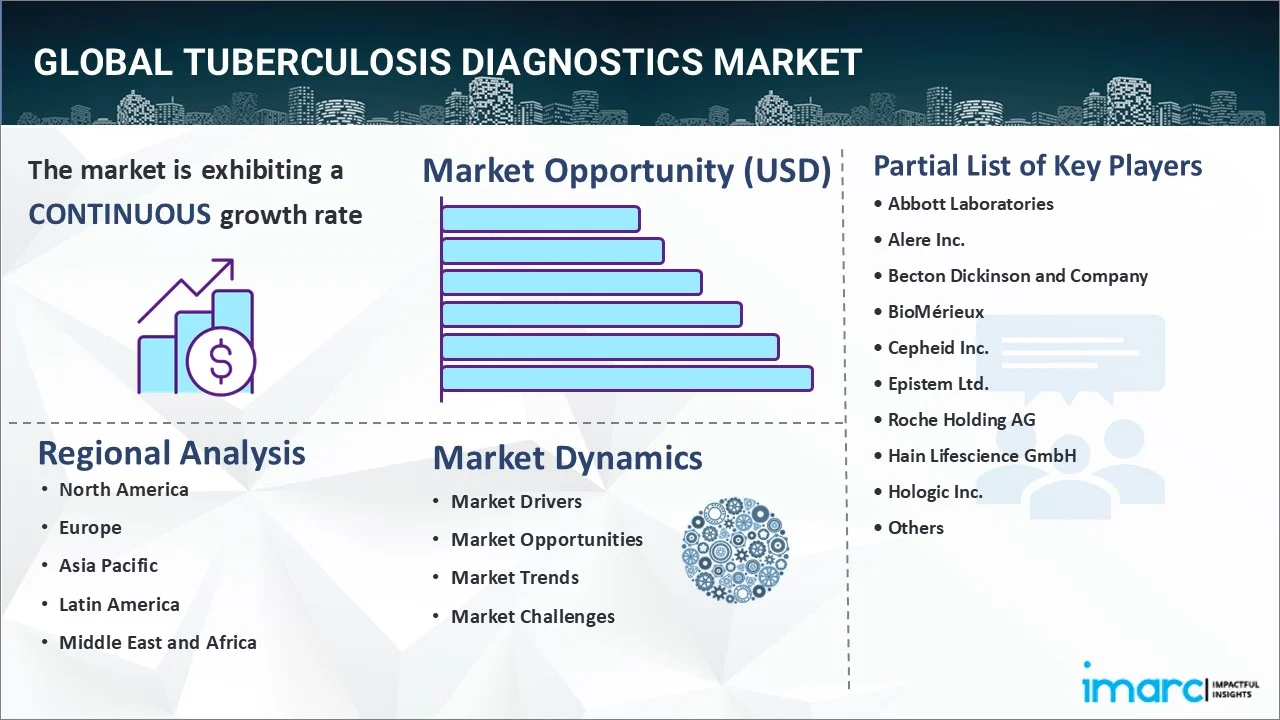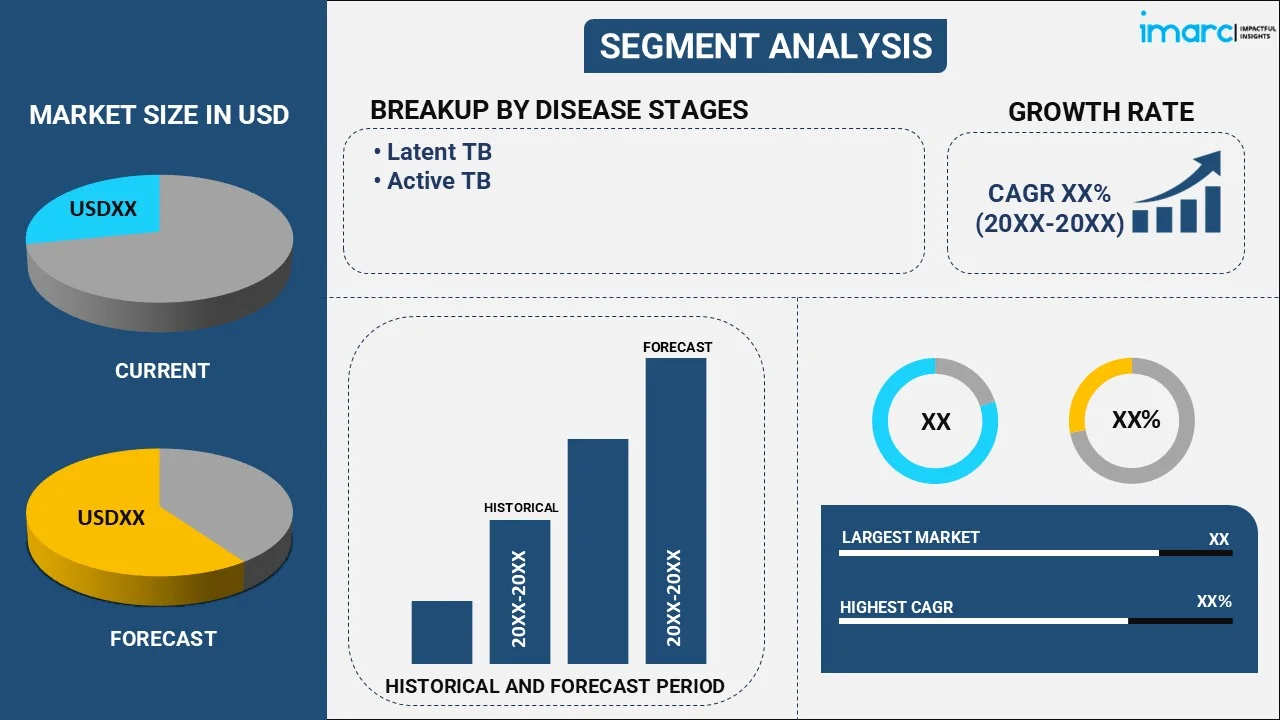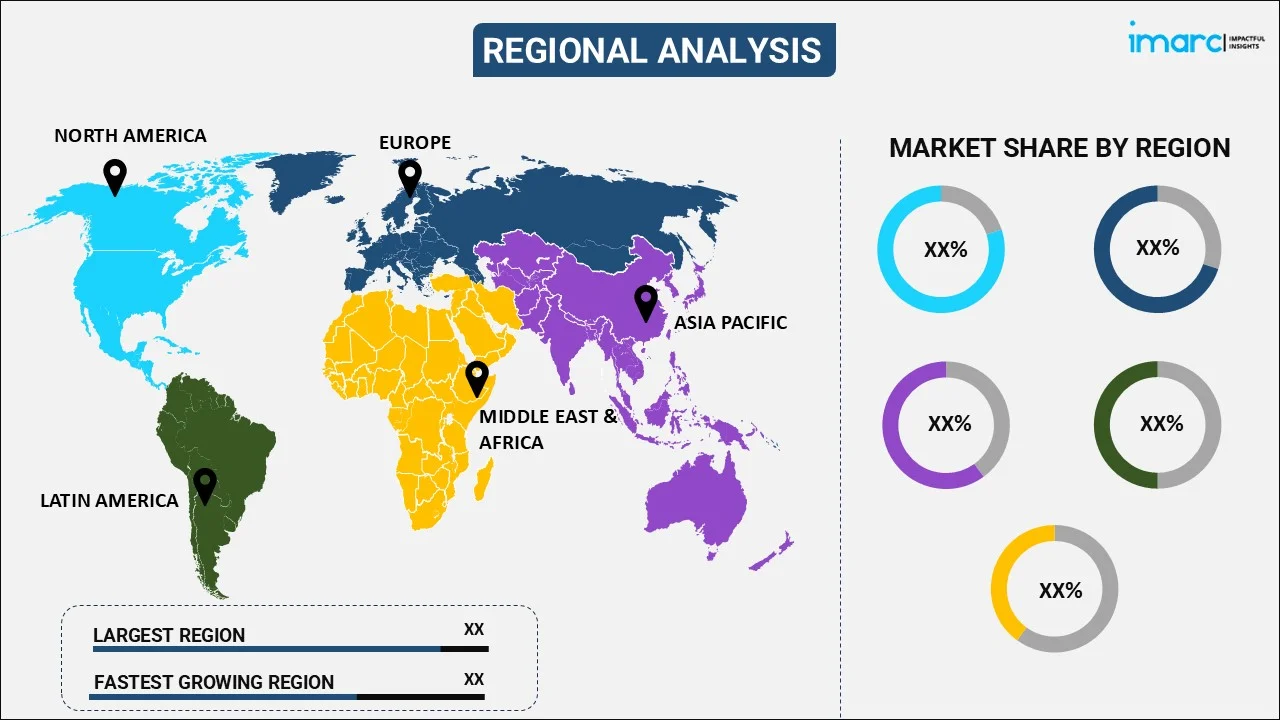
Tuberculosis Diagnostics Market Report by Disease Stage (Latent TB, Active TB), Test Type (Radiographic Test, Laboratory Test, Nucleic Acid Testing, Cytokine Detection Test, Drug Resistance Test, and Others), End-User (Hospitals and Clinics, Diagnostics and Research Laboratories, and Others), and Region 2025-2033
Market Overview:
The global tuberculosis diagnostics market size reached USD 2.6 Billion in 2024. Looking forward, IMARC Group expects the market to reach USD 3.8 Billion by 2033, exhibiting a growth rate (CAGR) of 4.01% during 2025-2033.
|
Report Attribute
|
Key Statistics
|
|---|---|
|
Base Year
|
2024
|
|
Forecast Years
|
2025-2033
|
|
Historical Years
|
2019-2024
|
|
Market Size in 2024
|
USD 2.6 Billion |
|
Market Forecast in 2033
|
USD 3.8 Billion |
| Market Growth Rate 2025-2033 | 4.01% |
Tuberculosis (TB) refers to an infectious bacterial disease that primarily affects the lungs (pulmonary), along with other parts of the body (extrapulmonary). The infection is diagnosed via a Mantoux tuberculin skin test (TST) or the TB blood test. Additional tests are required to confirm TB disease, depending on the infected organs. In the case of pulmonary TB, chest radiography is performed for detecting chest abnormalities, along with acid-fast staining and microscopic examination of the patient’s sputum. Extrapulmonary TB can be diagnosed using CT, MRI or ultrasound scans, endoscopy, laparoscopy, urine and blood tests, biopsies, and lumbar punctures.

Tuberculosis Diagnostics Market Trends:
The increasing prevalence of multi-drug resistant (MDR) tuberculosis across the globe is one of the key factors driving the growth of the market. MDR tuberculosis is caused by bacteria that are resistant to isoniazid and rifampicin, which are considered to be among the most potent antimicrobial drugs for TB. Furthermore, the availability of technologically advanced Point-of-Care (POC) diagnostic methods is also providing a boost to the market growth. Advanced diagnostic methods, such as Nucleic acid amplification tests (NAATs) and Interferon-Gamma Release Assay (IGRA), are more accurate, convenient, and provide prompt results in comparison to the traditionally used techniques. Additionally, significant improvements in the healthcare infrastructure, along with the growing awareness among the masses about various diagnostic procedures, are acting as another growth-inducing factor. Other factors, including the rising geriatric population and increasing healthcare expenditure and government initiatives and investments to promote research and development (R&D) activities, are projected to drive the market further.
Key Market Segmentation:
IMARC Group provides an analysis of the key trends in each sub-segment of the global tuberculosis diagnostics market report, along with forecasts at the global, regional and country level from 2025-2033. Our report has categorized the market based on disease stage, test type, and end-user.
Breakup by Disease Stage:

- Latent TB
- Active TB
Breakup by Test Type:
- Radiographic Test
- Laboratory Test
- Smear Microscopy
- Culture-based Test
- Nucleic Acid Testing
- Cytokine Detection Test
- Drug Resistance Test
- Others
Breakup by End-User:
- Hospitals and Clinics
- Diagnostics and Research Laboratories
- Others
Breakup by Region:

- North America
- United States
- Canada
- Asia Pacific
- China
- Japan
- India
- South Korea
- Australia
- Indonesia
- Others
- Europe
- Germany
- France
- United Kingdom
- Italy
- Spain
- Russia
- Others
- Latin America
- Brazil
- Mexico
- Others
- Middle East and Africa
Competitive Landscape:
The competitive landscape of the industry has also been examined with some of the key players being Abbott Laboratories, Alere Inc., Becton Dickinson and Company, BioMérieux, Cepheid Inc., Epistem Ltd., Roche Holding AG, Hain Lifescience GmbH, Hologic Inc., QIAGEN GmbH, Siemens, Thermo Fisher Scientific Inc., etc.
Report Coverage:
| Report Features | Details |
|---|---|
| Base Year of the Analysis | 2024 |
| Historical Period | 2019-2024 |
| Forecast Period | 2025-2033 |
| Units | Billion USD |
| Segment Coverage | Disease Stage, Test Type, End-User, Region |
| Region Covered | Asia Pacific, Europe, North America, Latin America, Middle East and Africa |
| Countries Covered | United States, Canada, Germany, France, United Kingdom, Italy, Spain, Russia, China, Japan, India, South Korea, Australia, Indonesia, Brazil, Mexico |
| Companies Covered | Abbott Laboratories, Alere Inc., Becton Dickinson and Company, BioMérieux, Cepheid Inc., Epistem Ltd., Roche Holding AG, Hain Lifescience GmbH, Hologic Inc., QIAGEN GmbH, Siemens, Thermo Fisher Scientific Inc. |
| Customization Scope | 10% Free Customization |
| Post-Sale Analyst Support | 10-12 Weeks |
| Delivery Format | PDF and Excel through Email (We can also provide the editable version of the report in PPT/Word format on special request) |
Key Questions Answered in This Report:
- How has the global tuberculosis diagnostics market performed so far and how will it perform in the coming years?
- What are the key regional markets?
- What has been the impact of COVID-19 on the global tuberculosis diagnostics market?
- What is the breakup of the market based on the disease stage?
- What is the breakup of the market based on the test type?
- What is the breakup of the market based on the end-user?
- What are the various stages in the value chain of the industry?
- What are the key driving factors and challenges in the industry?
- What is the structure of the global tuberculosis diagnostics market and who are the key players?
- What is the degree of competition in the industry?
Need more help?
- Speak to our experienced analysts for insights on the current market scenarios.
- Include additional segments and countries to customize the report as per your requirement.
- Gain an unparalleled competitive advantage in your domain by understanding how to utilize the report and positively impacting your operations and revenue.
- For further assistance, please connect with our analysts.
 Inquire Before Buying
Inquire Before Buying
 Speak to an Analyst
Speak to an Analyst
 Request Brochure
Request Brochure
 Request Customization
Request Customization




.webp)




.webp)












